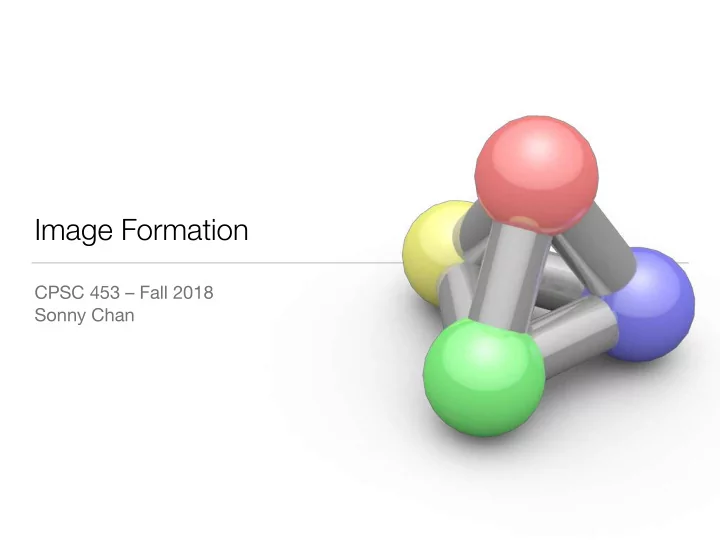

Image Formation CPSC 453 – Fall 2018 Sonny Chan
Outline for Today • The Camera Obscura • The geometry of perspective • The anatomy of a camera
The Camera Obsura ca. 4th century BC
Camera Obscura, 1946 San Francisco, California
Camera Obscura, 2012 Cheverie, Nova Scotia
Why is the projected image upside down?
Why do we care about this all this stuff anyway?
Perspective a geometric explanation
One-Point Perspective
Two-Point Perspective
Three-Point Perspective
Three-Point Perspective
Perspective is how we see a 3D picture on a 2D image
A Camera Obscura for photography? Sharan Pinhole Cameras, Japan
The Pinhole Camera What are its key advantages and disadvantages? [from civilwar150pinholeproject.com]
The Modern Camera Pentax Spotmatic, ca. 1960s
What’s the difference between the two cameras?
Lenses They let us get more light!!!
image object
Try taking a picture… of this “Prairie Chicken”
1 + 1 = 1 Thin Lens Equation S 1 S 2 f
Focusing To focus on objects at various distances, move the lens relative to the image/film plane. [courtesy of P . Hanrahan, Stanford University]
Circles of Confusion
image object circle of confusion
How big 1 + 1 = 1 S 1 S 2 f is your picture?
What determines your field of view?
Putting it all together… Nikon D3 cutaway
The Goal Get as much light onto here as possible! [from 1derful.info]
[from pierretoscani.com]
focal length aperture The image is controlled by shutter speed film sensitivity lens characteristics
Focal Length • You can’t change the size of your film! - nor your image sensor • Longer focal length means moving the film back more • Lens pupil gets smaller • Longer focal length = smaller field of view
Focal Length on a 35mm Frame
[from digital-photography-student.com]
Aperture • Measured in f-number : ratio of lens focal length to diameter of lens aperture - • Larger aperture lets more light in, but circle gets bigger result is “depth of field” effect -
[from ormsdirect.co.za]
Shutter Speed 1/10 s 1/125 s 1/1000 s [courtesy of K. Breeden, Stanford University]
Film Sensitivity ISO 800 ISO 1600 ISO 3200 [courtesy of K. Breeden, Stanford University]
Lens Characteristics good lens bad lens
Chromatic Aberration
In Summary
Things to Remember • The camera obscura , or pinhole camera, allows us to capture images of the world in perspective • Using a lens allows us to gather more light but introduces a plethora of variables to account for - focal length, aperture size, shutter speed, and film sensitivity - chiefly determine the appearance of your picture • Understanding how real-world images are formed helps us to synthesize artificial, but realistic digital images
Recommend
More recommend